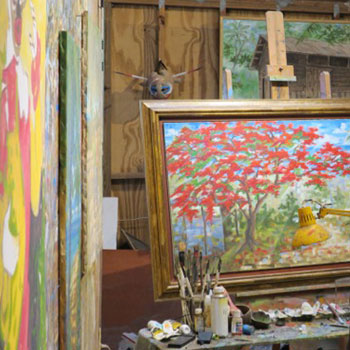We use cookies on this site to enhance your experience.
By selecting “Accept” and continuing to use this website, you consent to the use of cookies.

The culture and diversity of Puerto Rico leave many to marvel at how this uniqueness has survived. One of the many ways that this diversity has survived is through artisans and creative people living and breathing ideals and traditions of the past. A well-known artist, Samuel Lind, connects deeply to the earth and nature much like early Puerto Ricans did. Lind is well known for his depictions of nature and community, but he has a special focus on the Afro-Puerto Rican experience. He lives and works in Loiza, an Afro-Puerto Rican town settled by former African slaves, which is the beating heart of African culture in Puerto Rico today. Lind’s gallery and studio are incorporated into his home, with varying studio spaces stretching over multiple floors and past signs of everyday life. Passing through his garage and parked car you find a small room with a portrait of a young girl in the works, as well as a completed statue ready for final touches or a buyer. His cat sits on the table on top of a print seemingly accustomed to this life of constant creativity. It mirrored in my mind an old Taino (indigenous Puerto Rican) village of movement and work being integrated with everyday living.
One the pieces of art that stood out in his house was a picture of women resembling mother earth. He used a contrasting light and dark colour palate to resemble night and day. This connection to earth is what makes the whole area of Loiza unique and special. This art gallery is also filled with art pieces resembling and inspired by people of the community. I purchased a piece that was modeled after an Afro-Puerto Rican woman who lived at the top of his street. She is pictured doing the Bomba, a traditional dance originating in the African slave culture of the sugar and coffee plantation era. Lind also has paintings of beaches and what appear to be ordinary people walking in nature. This connection to the earth and nature struck me as a fascinating tribute to the way of life of the Taino and Afro-Puerto Ricans. It is a way of life that celebrated nature and the world that they lived in. Samuel Lind’s studio, nestled in the trees and immersed in art is a fabulous place not only to visit and purchase art, but to immerse yourself in the ways of Puerto Rico’s African heritage. His work keeps the island’s African heritage alive and presents it for the world to celebrate and remember.